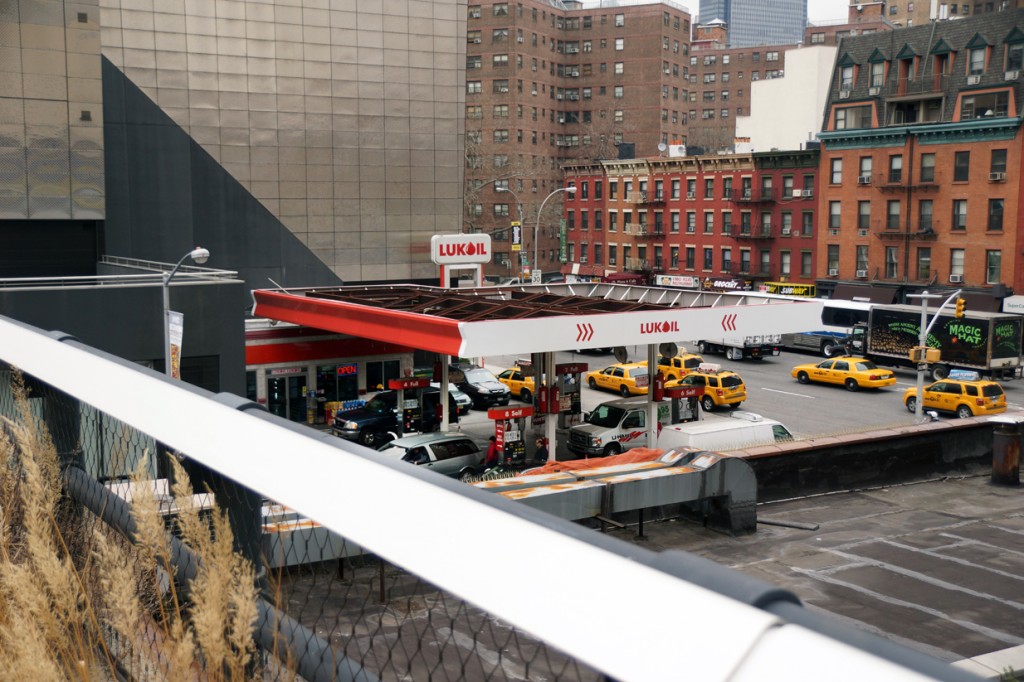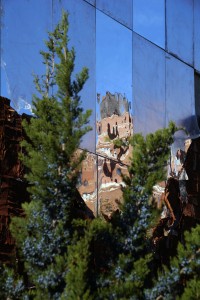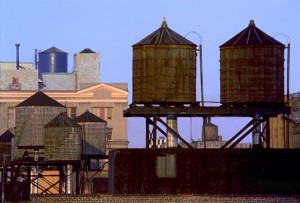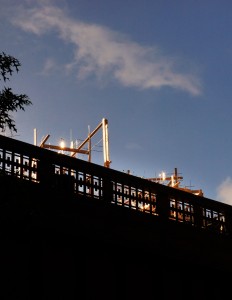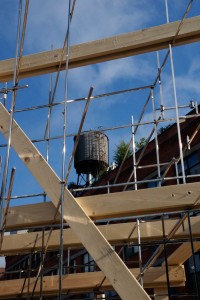One doesn’t naturally associate Vladimir Putin with the High Line, but once upon a time he was a stakeholder here. Back in 2000 Lukoil, the giant Russian oil conglomerate, purchased Getty Oil and its 1,300 gas stations, including a small one on 24th Street and Tenth Avenue. Putin himself attended the grand opening, and it was widely reported that he enjoyed a Krispy Creme donut under the shadow of the still-abandoned High Line.
art
“So atop the city that taught the world what modern cities ought to be, there they are, the hoops and staves of the Middle Ages.” — Charles Kuralt
This blog is no danger of becoming LivinTheWaterTower.com, Scout’s honor, but I’ve had such an interesting response to recent pieces about New York’s water towers that I wanted to share what fellow tank enthusiasts have passed along.
I had no idea, until I learned about the Water Tank Project and started paying closer attention, that New York’s water towers have for many years been a source of artistic expression for a wide variety of artists. When the Water Tank Project opens next Spring New Yorkers will have the pleasure of seeing hundreds of tank-inspired works of art on display all over the city, by both established and emerging artists. Until then, here’s a few earlier works to enjoy. I’ll continue to update this list. If you have a work you’d like to tell me about, please email me using the contact form.
My photo captures the reflection of the beautiful brick structures that house the water tanks of the London Terrace apartments in the pressed tin and mirrors of El Anatsui’s installation-in-progress on 21st Street. The work is called Broken Bridge II and is part of the High Line’s excellent public art program. Read more about it here. I walked the High Line today and, to my delight, noticed this natural, impromptu blending of art + water towers. As always, click the image to enlarge it.
“Silent Sentries,” a short documentary by Jane Martin. The person who wrote to me about this film, which originally aired on PBS about 20 years ago, remembered a Greek chorus of New Yorkers who, when asked what the water tanks were, came up with a host of perfectly ridiculous but often marvelous (in that Only-in-New York kind of way…) answers and speculations. I found Jane Martin on the web and and she very kindly mailed me a DVD of the film. Yes, the comments from our fellow citizens are amusing, but what I loved about this film is the narrative that Martin un-spools. Somehow she managed to find and film the renovation of one water tank — it’s on the West Side, somewhere in the 50s, I think, but it’s hard to know for sure — and her film roughly documents the removal of the existing tank and its replacement with a brand new one. Her shots of the men at work are wonderful — often they seem completely unaware of the camera — and best of all you get the vivid (and sometimes vertiginous) sensation of actually being on the roof of a New York building and seeing the city from the point of view of a water tower. You also get a deep understanding of how these things are constructed. I suppose this shouldn’t have surprised me, but I was fascinated to realize that the water tanks have to be built on-site, they can’t simply be lifted up by a crane and installed ready-made. So while the modern city hums below, these beefy, expert guys practice a centuries-old art on the rooftops above. It’s a vivid and surprising film, and while it’s not currently available for streaming you can contact Jane via this email address about purchasing a copy: SilentSentries@janemartinart.com. For more about the film, visit JaneMartinArt.com. I hope that PBS will re-air the film next year when the Water Tank Project goes up.
“The Water Tower Player” (“Le Joueur de Citernes”) a film made by French filmmaker Emmanuel Gorinstein. Read my blog post about the film here, or go directly to Vimeo to watch it. Be ready for magic.
Tom Fruin’s Watertower, Dumbo, Brooklyn. Installed June 2012. This sculpture sits on the rooftop of 20 Jay Street and is visible from the Dumbo section of Brooklyn as well as the Brooklyn and Manhattan Bridges, the FDR Drive, and points in Lower Manhattan. The piece is made from reclaimed materials: steel plus roughly 1,000 scraps of salvaged plexiglass in every color of the rainbow, and is part of series of works that pay tribute to architectural icons around the world. The sun lights the piece by day, and at night it’s lit by Arduino-controlled light sequences designed by Ryan Holsopple. Read more about it and see gorgeous photos — shot in daylight and at night — on TomFruin.com.
Rachel Whiteread’s Water Tower, SoHo, New York. According to the Museum of Modern Art’s website, British artist Whiteread was commissioned by the Public Art Fund in 1998 to create this work of public art, and she “scoured the city in search of a quintessentially New York subject.” Like many artists, she looked up and saw water towers, and conceived this sculpture, which is a resin cast of the interior of a once-functioning cedar water tank. According the MoMA website, “The translucent resin captures the qualities of the surrounding sky; the sculpture’s color and brightness change throughout the day and it becomes a near-invisible whisper at night.” Whiteread has called the work “a jewel on the skyline of Manhattan.” The sculpture now sits on the roof of MoMA, so you can check it out yourself next time you’re there. Read more and see a photograph on MoMA.org.
Sarah Sze’s marvelous and hugely popular Still Life With Landscape (Model for a Habitat) has moved from the spot it occupied for the past year (near 20th Street), but it hasn’t left the High Line yet. And in fact this piece continues to dazzle, even as it sits in packing mode in a temporary holding place just above 22nd Street. This is surely the mark of a true work of art: no matter where it sits, it draws us in and gives us the pleasure of its company.
Today, Still Life With Landscape offered a new framing device for the water towers atop the Spears Building. Always beautiful, these towers are now downright sculptural, framed by Sze’s steel lines. Early this morning light glinted off the metal, and the sculpture — now in many pieces — invited the viewer to peek and peer from every angle possible.
Check it out quickly, because this piece is leaving soon for good. But how nice to get a second look before it goes.

